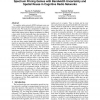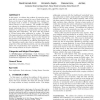126
click to vote
MOBIHOC
2010
ACM
14 years 10 months ago
2010
ACM
In cognitive radio networks (CRN), primary users can lease out their unused bandwidth to secondary users in return for a fee. We study price competition in a CRN with multiple pri...
127
click to vote
MOBIHOC
2010
ACM
14 years 10 months ago
2010
ACM
We present the Whirlpool Routing Protocol (WARP), which efficiently routes data to a node moving within a static mesh. The key insight in WARP's design is that data traffic c...
104
click to vote
MOBIHOC
2010
ACM
14 years 10 months ago
2010
ACM
In many practical scenarios, nodes gathering at points of interest yield sizable connected components (clusters), which sometimes comprise the majority of nodes. While recent anal...
146
click to vote
MOBIHOC
2010
ACM
14 years 10 months ago
2010
ACM
We explore the problem of detecting whether a device has moved within a room. Our approach relies on comparing summaries of received signal strength measurements over time, which ...
125
click to vote
MOBIHOC
2010
ACM
14 years 10 months ago
2010
ACM
We investigate the performance of longest-queue-first (LQF) scheduling (i.e., greedy maximal scheduling) for wireless networks under the SINR interference model. This interference...
123
click to vote
MOBIHOC
2010
ACM
14 years 10 months ago
2010
ACM
Dynamic spectrum auction is an effective solution to provide spectrum on-demand to many small wireless networks. As the number of participants grows, bidder collusion becomes a se...
112
click to vote
MOBIHOC
2010
ACM
14 years 10 months ago
2010
ACM
In geographic (or geometric) routing, messages are expected to route in a greedy manner: the current node always forwards a message to its neighbor node that is closest to the des...
MOBIHOC
2010
ACM
14 years 10 months ago
2010
ACM
We investigate the scalability of a class of algorithms that exploit the dynamics of wireless fading channels to achieve secret communication in a large wireless network of n rando...
120
click to vote
MOBIHOC
2010
ACM
14 years 10 months ago
2010
ACM
In this paper, we address the problem of preserving generated data in a sensor network in case of node failures. We focus on the type of node failures that have explicit spatial s...
119
click to vote
MOBIHOC
2010
ACM
14 years 10 months ago
2010
ACM
Comparing with the classical barcode system, RFID extends the operational distance from inches to a number of feet (passive RFID tags) or even hundreds of feet (active RFID tags)....





